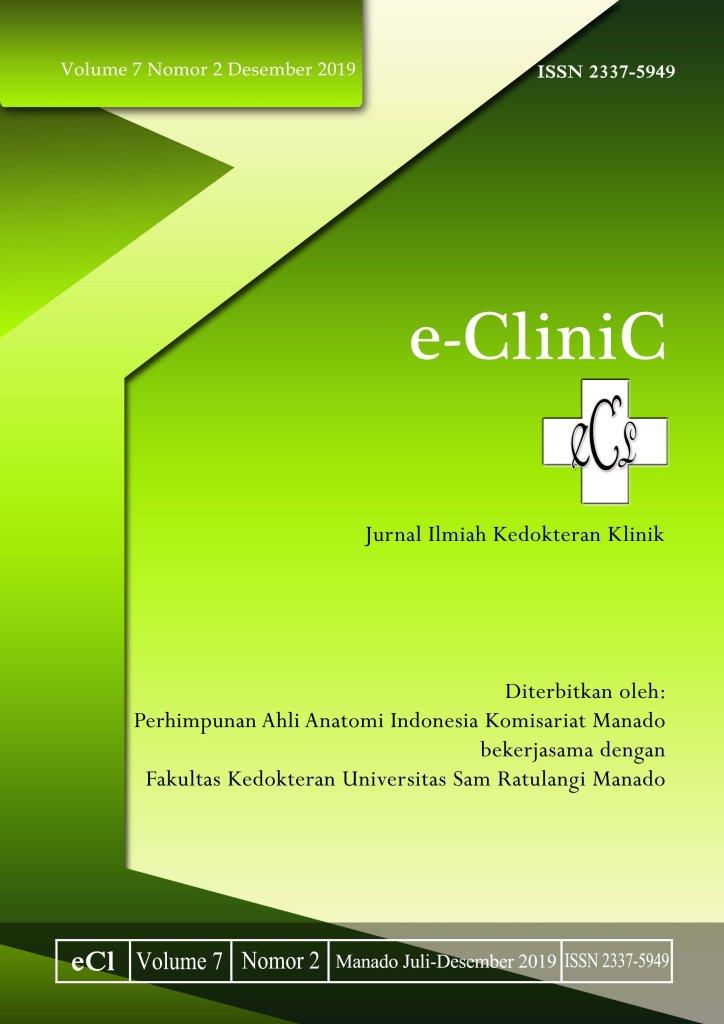Perbedaan Derajat Ansietas antara Penyandang Hipertensi Belum Terkontrol dengan yang Terkontrol
DOI:
https://doi.org/10.35790/ecl.v7i2.26283Abstract
Abstract: Hypertension and anxiety are among the group of the most common chronic disease worldwide, and according to numerous studies they are oftentimes associated each other. Patients suffered from chronic illnesses, such as hypertension, may have negative emotion that increases the risk of mental disorders, most commonly anxiety disorder. This study was aimed to assess the difference of anxiety degree between uncontrolled and controlled hypertensive patients. This was an observational analytical study with a cross-sectional design. Subjects were divided into two groups: controlled and uncontrolled hypertensive patients. Measurement of blood pressure parameter was performed by using office blood pressure monitoring. Anxiety parameter was classified based on the scoring of the Generalized Anxiety Disorder Scale (GAD-7). Data were analyzed by using the Mann-Whitney test. Subjects consisted of 60 hypertensive patients (35 males and 25 females), aged 30-70 years (mean 56.48 years). There were 35 controlled hypertension patients and 22 uncontrolled hypertensive patients. The results showed that the difference in anxiety degree based on GAD-7 between controlled hypertensive and uncontrolled hypertensive groups obtained a p-value of 0.000. In conclusion, there was a significant difference in anxiety degree between uncontrolled and controlled hypertensive patients. Screening for anxiety among hypertensive patients is a simple and cost-effective tool that may improve outcomes.
Keywords: anxiety, uncontrolled hypertension, controlled hypertension
Â
Abstrak: Hipertensi dan ansietas merupakan kelompok penyakit kronik yang paling umum di seluruh dunia. Berdasarkan banyak penelitian kedua penyakit ini saling berhubungan satu sama lain. Penyandang hipertensi mungkin memiliki emosi negatif yang meningkatkan risiko terjadinya gangguan mental berupa ansietas. Ansietas dan dukungan sosial rendah akan menghambat proses penyembuhan terutama dalam mengontrol tekanan darah. Penelitian ini bertujuan untuk menge-tahui apakah terdapat perbedaan derajat ansietas antara penyandang hipertensi belum terkontrol dengan hipertensi terkontrol. Jenis penelitian ialah analitik observasional dengan desain potong lintang. Subyek penelitian dibagi menjadi dua kelompok, yaitu kelompok penyandang hipertensi belum terkontrol dan hipertensi terkontrol. Pengukuran parameter tekanan darah dilakukan dengan menggunakan alat Oscillometric digital dengan cara Office Blood Pressure Monitoring (OBPM). Parameter ansietas diklasifikasikan berdasarkan skala Generalized Anxiety Disorder Scale (GAD-7). Adanya perbedaan derajat ansietas antara kedua kelompok dinilai dengan uji Mann-Whitney. Subyek penelitian terdiri dari 60 penyandang hipertensi (35 laki-laki dan 25 perempuan) berusia 30-70 tahun (rerata 56,48 tahun). Terdapat 25 penyandang hipertensi yang belum terkontrol dan 35 penyandang hipertensi terkontrol. Hasil penelitian menunjukkan bahwa terdapat perbedaan derajat ansietas berdasarkan GAD-7 antara kedua kelompok (p=0,000). Simpulan penelitian ini ialah terdapat perbedaan bermakna dalam derajat ansietas antara penyandang hipertensi yang belum terkontrol dengan yang terkontrol. Skrining ansietas pada penyandang hipertensi merupakan modalitas penting dalam penatalaksanaan penyandang hipertensi.
Kata kunci: ansietas, hipertensi belum terkontrol, hipertensi terkontrol
Downloads
How to Cite
Issue
Section
License
COPYRIGHT
Authors who publish with this journal agree to the following terms:
Authors hold their copyright and grant this journal the privilege of first publication, with the work simultaneously licensed under a Creative Commons Attribution License that permits others to impart the work with an acknowledgment of the work's origin and initial publication by this journal.
Authors can enter into separate or additional contractual arrangements for the non-exclusive distribution of the journal's published version of the work (for example, post it to an institutional repository or publish it in a book), with an acknowledgment of its underlying publication in this journal.
Authors are permitted and encouraged to post their work online (for example, in institutional repositories or on their website) as it can lead to productive exchanges, as well as earlier and greater citation of the published work (See The Effect of Open Access).







